Requirements for refractory mortar in refractory brick masonry
(1) The working conditions of the mud in the joints of refractory masonry bricks are exactly the same as those of refractory bricks. Therefore, the main technical indicators of the two, refractoriness and chemical composition, should also be the same or compatible.
(2) The type and brand of mud should be selected by the designer according to the working conditions of the furnace.
(3) The types and compositions of mud generally used in refractory products.
Mud consistency
Before refractory masonry is built, the consistency of the mud and the amount of water to be added should be determined through tests according to the type of masonry. Different types of masonry are suitable for muds of different consistencies. In recent years, finished muds mixed with admixtures have been widely used, basically eliminating the original ordinary refractory muds.
Bonding time
The bonding time of the mud depends on the material and size of the refractory product, and is preferably 1 to 1.5 minutes.
The determination of mud consistency should be carried out according to the method specified in the current industry standard “Test method for refractory mud consistency” YB/T 5121.
The determination of mud bonding time should be carried out according to the method specified in the current industry standard “Test method for refractory mud bonding time” YB/T 5122.
Maximum particle size of finished mud
Since construction units generally lack the necessary mixing, screening and testing equipment, it is difficult to accurately mix the ingredients and mix them evenly. Therefore, finished mud should generally be used instead of preparing mud on site. The maximum particle size of the mud should not be greater than 30% of the specified brick joint thickness.
Mud preparation
When preparing the mud, various ingredients must be measured accurately and stirred evenly. It is strictly forbidden to add water or binders to the prepared mud at will, otherwise the specified consistency or mix ratio of the mud will be changed, affecting its masonry performance and reducing its high temperature performance.
When preparing mud with admixtures in coastal areas, the mixing water should be tested and its chloride ion content should not be greater than 300mg/L. Because the higher the chloride ion concentration, the shorter the bonding time of the mud, the faster the solidification and hardening, which is not conducive to masonry operations. Secondly, the shear strength and flexural strength of the mud will decrease due to the increase in chloride ion concentration in the water.
More details about refractory mortar
What is a refractory mortar?
Refractory mortar is a strong liner used in industrial furnaces and kilns to protect buildings in steel mills, glass manufacturers, and ceramic manufacturing sites. It serves as a relentless protection, making sure these blazing cauldrons stay their shape and withstand the continual severe heat.
What’s the difference between refractory mortar and refractory cement?
In conclusion, the difference between refractory mortar and refractory cement is that mortar is used to join shaped materials and on the other hand, refractory cement is used as a binder material for refractory castables.
What is refractory mortar used for?
It is used to join refractory bricks, tiles, and other heat-resistant materials, creating a strong and durable bond that can withstand thermal expansion, contraction, and high-temperature environments.
What is the difference between cement mortar and mortar?
Cement (also called Portland cement) is a fine binding powder that is never used alone but is a component of concrete and mortar, stucco, tile grout, and thin-set adhesive. Mortar contains cement, fine sands, and lime; it binds materials when building with brick, block, and stone.

